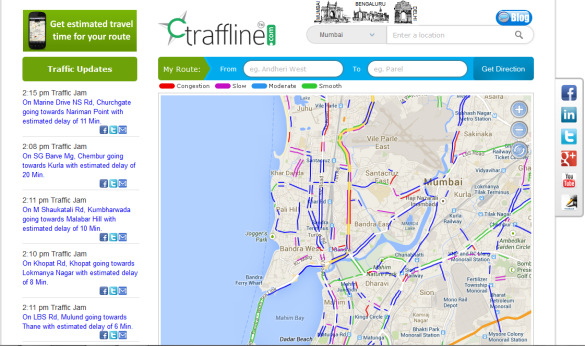Realtime Traffic and trabel information portal Traffline raises Series A funding from Matrix Partners
– By Prathamesh Patil
Matrix Partners India today announced that it has invested in the first institutional round of funding for Birds Eye Systems Private Limited, which offers real-time traffic and travel information for Indian cities through a variety of mobile and internet channels under the Traffline brand.
Brijraj Vaghani, the co-founder and CEO, has extensive experience in the mobile sector with Qualcomm and Nextwave Wireless in the US, before moving back to India and starting Birds Eye Systems. His co-founder and CTO, Ravi Khemani, has worked previously with careerbuilder.com in the US and Sears International in India.
“Getting access to accurate and real-time traffic, travel and local information is a large problem for millions of Indian commuters in major cities. We want to address this problem using an approach tailored to Indian ethos and travel conditions. We partner with private players, government, police, public transport utilities and our users to ensure that information is real-time. We aim to own the everyday door-to-door travel and information space on mobile, be it private vehicles, public transport, or local businesses, across major Indian cities” said Brijraj Vaghani and Ravi Khemani, co-founders, Birds Eye Systems Private Limited
Nitin Agarwal – Investor, IAN said “We are very pleased for the Traffline team. This is an endorsement of our belief in the company and its founders, as well as of the ability of IAN to source, evaluate, and nurture high-potential startups at a very early stage.” Rajiv Dadlani – Investor, IAN added “We have always believed in Brij and Ravi. Their focus and determination was the key factor in our investment decision at the angel stage. We look forward to continuing to work with them, as well as with Matrix Partners India, to grow Birds Eye into a valuable company.”
“We are excited by Traffline’s unique approach of using technology to solve the offline traffic and transportation problem in India. Traffline is a pioneer in this space and we’re investing to expand the product to 10 cities in India and multiple transport modes in a short timeframe. We look forward to partnering with Brij and Ravi in their journey to build a large company. We continue to focus on more early stage investments in the mobile space in India.” said Vikram Vaidyanathan, Director, Matrix India
Birds Eye Systems provides real-time traffic information across 4 major Indian cities under the Traffline brand. Traffline’s products already have several hundred thousand users, and have been covered extensively in major offline and online media outlets. With a network of data sources running into several thousands, Traffline prides itself on its ability to provide short, contextual, conversational calls to action to millions of commuters daily.

